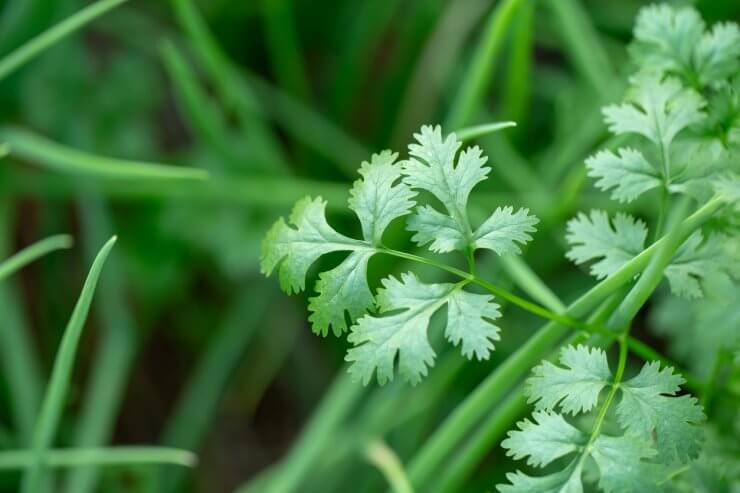
Healthy, disease-free cilantro plant
Like all food crops, cilantro is susceptible to various fungal and bacterial diseases. Your best weapons against these are best planting practices, which help prevent disease in the first place.
This is especially important, as there are no fungicides approved for home use for many diseases.
These best practices are aimed at producing strong, healthy plants that can withstand disease, and at avoiding situations that contribute to the development of disease. They involve keeping plants clean, dry, and undamaged.
Watering: Water your cilantro deeply about once a week (check the soil for dryness). Do not over-water; soggy soil invites disease. Water your plants at the base near the soil, not from above.
Mulch: Mulch can help with water retention—but be vigilant and check for insect or fungal activity.
Other best practices include:
- Buy healthy, disease-free plants and seeds from reputable sources
- Plant your cilantro where it can get plenty of sun and airflow
- Plant in sites with good drainage
- Harvest frequently and remove infected plants and fruit
Common cilantro diseases
Here are some of the usual culprits that might infest your cilantro plants. Remember, it’s important to remove diseased stems, flowers, and leaves to prevent the spread of disease once it’s found its way onto your plant.
Bacterial Leaf Spot
Cause: Bacteria
Symptoms:
- tan, brown, or black spots on leaf surfaces, often surrounded by yellow halos
- yellow, withering, or dropping leaves
How it Spreads:
- spread by rain, splashing water
- exposure to other infected plants
Treatment:
- remove and discard infected parts
- apply copper-based fungicides or sulfur sprays to stop the spread
Prevention:
- always water the soil around the base of the plant; avoid wetting leaves
- avoid excessive fertilization
- choose disease resistant seeds
Powdery Mildew
Cause: Fungus
Symptoms:
- powdery growth on leaves and stems
- pale stalks (lack of chlorophyll)
- misshapen blossoms
How it Spreads:
- floats on air currents, usually in high humidity and warm temperatures
Treatment:
- if caught early, treat with sulfur or potassium bicarbonate
Prevention:
- use fungicidal sprays appropriate for cilantro, according to manufacturer’s instructions
- avoid overfertilizing
- use disease-free seeds
- rotate crops
- remove weeds and debris from around plants
Soft Rot
Cause: Bacteria
Symptoms:
- soft, sunken, brown appearance of petioles (where the leaf stem meets the main stem)
How it Spreads:
- contaminates new plants through water and soil
Treatment:
- no treatment available; remove and safely dispose of plants.
Prevention:
- plant cilantro in well-draining soil
- allow plants to dry between waterings
- avoid harming plants while harvesting
- regularly clean all equipment used frequently
Which diseases have you had to treat on your cilantro? Please tell us how you prevent and handle diseases. If you spot other symptoms on your cilantro that are not mentioned here, contact your local extension center or garden center for a consult—and please let us know what you discover.


 Previous
Previous

